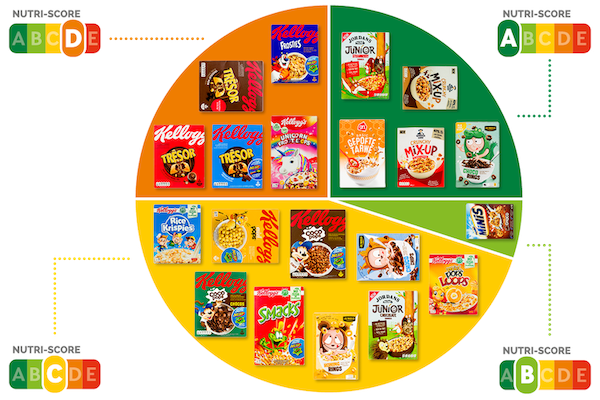On my last day travelling in the Netherlands, I stepped into a corner store to pick up a smoothie, when I stopped to examine the 5-colour scale on the front of the package.
Each bottle had a “Nutri-Score,” indicating a grade from A – E for its nutritional quality. I reached for the strawberry banana flavour, just to realize it had been given a C! The apple and kale flavour, however, had an A. Why was it that drinks of the same brand, with the same packaging, could have such different nutritional scores? I turned them around to read the detailed nutritional label on the back, and there it was: 5g of added sugar in the strawberry banana smoothie. Though I hadn’t stopped to study it until then, I noticed this colourful label on snack packages and bottled beverages during my trip through Europe.
A Different Take on Snack Tier Lists
The need for informative nutritional labelling is undeniable. As the leading cause of obesity, type-2 diabetes, and cardiovascular disease, poor diet is responsible for more deaths worldwide than any other risk factor. While policies mandating nutritional labelling ensure that nutritional information is available on all prepackaged foods, anything from lack of nutritional literacy to laziness means these labels get glossed over.
Nutri-Score is an easy-to-read front-of-pack (FOP) nutritional label used widely in European countries. Just like mainstream tier lists, Nutri-Score ranks your packaged food items, but unlike mainstream tier lists, there is more rigorous criteria than personal taste (based on the British Food Standards Nutrient Profiling System). Each food item will receive an “N Score” for contents negatively impacting the nutritional value, such as high energy density (high calorie), high sugar content, high saturated fats, and high salt content. Then, it will be awarded a “P Score” or positive points for fruit, vegetable, nut, legume, fibre, protein, and healthy oil content. The P score is subtracted from the N score, giving a final tally that will vary from -15 to +40, categorizing it into one of the letter values (from A to E). The lower the score, the greater the nutritional value. The final grade is reported on the packaging with the letter in bold:

Image Source: https://www.nolitafood.com/blogs/nutrition-tips/nutri-score-will-it-be-your-best-ally-when-shopping
As Dr. Mélanie Deschasaux in the International Agency for Research on Cancer’s Brief put it, “The Nutri-Score label […] provides a simple translation of data on nutritional composition, based on the strong evidence currently available, to guide consumers towards healthier food choices.”
Unexpected Grades
Just like with reading report cards, seeing an unexpected “C” is always a shock. As someone who has taken classes in nutrition and who peruses the back-of-pack declaration tables on my groceries, I thought my nutritional literacy was relatively strong. But even armed with my nutritional knowledge, I found it hard to compare smoothie options because there was no pattern to how food was organized by nutrition. FOP labelling combats just that. For example, these 20 different cereal boxes can be found on the shelf in the grocery store, yet they score anywhere from A to D. With varying serving sizes and the need for mental math, it’s understandable that many people don’t want to start crunching the numbers before crunching their cornflakes. The dual benefit of Nutri-Score is that it not only helps consumers make healthier food choices, but it also incentivizes food manufacturers to improve the nutritional quality of their products.

Image Source: https://www.shirleybrouwers.nl/nutri-score/
It’s true that nutritional information is generally available, but you have to know how to read it. Studies have shown that nutritional literacy is linked to higher education, meaning that some demographics are disproportionately affected by misleading food branding. Easy-to-read FOP labelling makes nutritional information more accessible and guides consumers to make healthier decisions. And when it comes to healthy eating, the EAT-Lancet report states that approximately 11 million diet-related deaths can be saved per year as a result of healthier diets. Unsurprisingly, there has been an enormous scientific and political push towards global FOP labelling.
Front-of-Package Labelling Around the World
While Nutri-Score is an eye-catching example, it’s certainly not the only type of FOP labelling out there. Most other labels are designed to provide either a warning for foods with unhealthy contents or a stamp of approval for those that are deemed healthy. Stop-sign warnings found in Chile, Uruguay, and Peru use the former approach. The stop signs are found on prepackaged foods with high levels of energy or nutrients of concern, with varying levels of severity. On the other hand, the Nordic Keyhole System, Choices Logo, and Healthier Choice Symbol award foods that meet a certain level of nutritional quality. These allow for a quick evaluation of healthy or not but don’t provide much detail. The UK’s traffic-light label or the Health Star Rating in Australia and New Zealand, on the other hand, provide quick summaries of the amount of contents of concern. Generally speaking, we’re looking out for high energy density, high saturated fats, high sodium, and high sugar.
Food manufacturers in Canada have been given until January 1, 2026, to transition to FOP labelling on all prepackaged foods that meet or exceed set sodium, sugars, or saturated fat levels. It looks like a magnifying glass pointing out these contents of concern. Similar to the stop sign but less flashy.

Image Source: https://www.canada.ca/en/health-canada/services/food-labelling-changes/front-package.html
While there is room to improve FOP label standardizing and ensuring that inclusion criteria are continually assessed, I was still impressed with this public health intervention and excited to see better nutrition labelling in Canada. And Nutri-Score helped me make better dietary decisions while I was in Europe. Just remember, similar to an academic report card, it’s okay if you don’t have all As. But it’s best if you can average out around a B.







